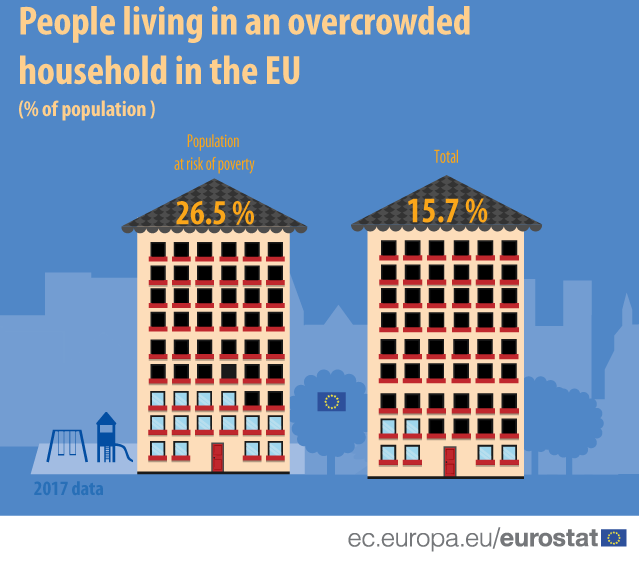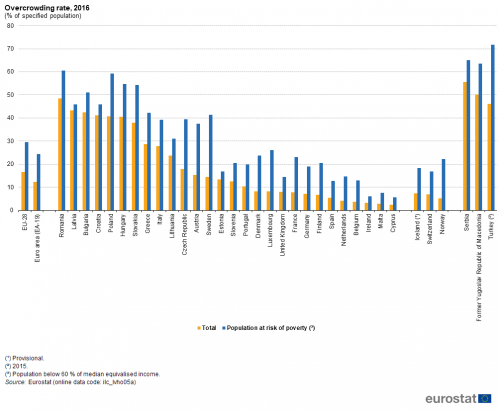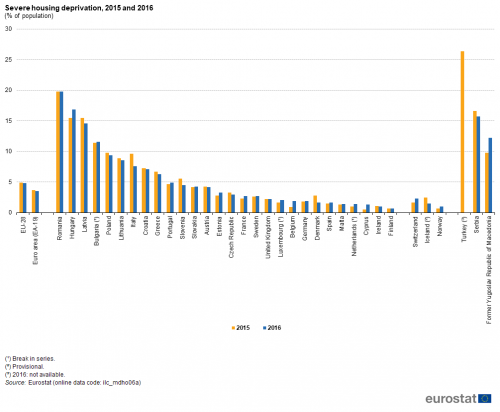Archive:Housing statistics
Data extracted in May 2018.
Planned article update: July 2019.
Highlights
A majority of the population in each EU Member State lived in owner-occupied dwellings in 2016, between 52 % in Germany and 96 % in Romania.
In 2016, one sixth of the EU population lived in overcrowded dwellings; the highest rate among the Member States was in Romania (48.4 %).
Across the EU, approximately 1 in 20 of the population suffered from severe housing deprivation in 2016.
In 2016 in the EU, housing cost overburden of tenants renting at market prices was highest in Greece: 84.6 % of them spent more than 40 % of their equivalised disposable income on housing. The EU average was 28.0 %.
This article provides an overview of recent statistics on housing in the European Union (EU), three of the EFTA countries and three candidate countries, focusing on dwelling types, tenure status (owning or renting a property), housing quality and affordability.
Decent housing, at an affordable price in a safe environment, is a fundamental need and considered by many to be a human right. Ensuring this need is met, which is likely to alleviate poverty and social exclusion, is still a significant challenge in a number of European countries.
Full article
Type of dwelling
In 2016, more than 4 out of every 10 persons (41.8 %) in the EU-28 lived in flats, close to one quarter (23.9 %) in semi-detached houses and just over one third (33.6 %) in detached houses (see Figure 1). The proportion of people living in flats was highest, among the EU Member States, in Spain, Latvia (both 66.1 %) and Estonia (62.0 %), while a similar proportion of people lived in flats in Switzerland (62.7 %). The highest proportions of people living in semi-detached houses were reported in the United Kingdom (60.1 %), the Netherlands (58.4 %) and Ireland (52.4 %); these were the only Member States where more than two fifths of the population lived in semi-detached houses. The share of people living in detached houses peaked in Croatia (71.0 %), Slovenia (65.5 %), Hungary (62.8 %) and Romania (61.9 %); the former Yugoslav Republic of Macedonia (72.9 %), Serbia (64.2 %) and Norway (59.9 %) also reported that a high proportion of their populations were living in detached houses.
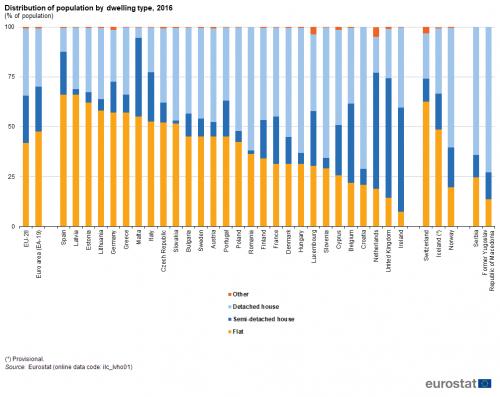
(% of population)
Source: Eurostat (ilc_lvho01)
Tenure status
In 2016, more than one quarter (26.6 %) of the EU-28 population lived in an owner-occupied home for which there was an outstanding loan or mortgage, while more than two fifths (42.6 %) of the population lived in an owner-occupied home without a loan or mortgage. As such, 7 out of every 10 (69.2 %) persons in the EU-28 lived in owner-occupied dwellings, while 19.9 % were tenants with a market price rent, and 10.8 % were tenants in reduced-rent or free accommodation.
More than half of the population in each EU Member State (see Figure 2) lived in owner-occupied dwellings in 2016, ranging from 51.7 % in Germany up to 96.0 % in Romania. As such, none of the EU Member States recorded a share of tenants that was higher than the share of people living in owner-occupied dwellings. By contrast, in Switzerland, the proportion of people who lived in rented dwellings outweighed those living in owner-occupied dwellings, as some 57.5 % of the population were tenants. In the Netherlands (61.0 %) and Sweden (54.8 %) more than half of the population lived in owner-occupied dwellings with an outstanding loan or mortgage; this was also the case in Iceland (63.9 %) and Norway (62.3 %).

(% of population)
Source: Eurostat (ilc_lvho02)
The share of people living in rented dwellings with a market price rent in 2016 was less than 10.0 % in 11 of the EU Member States. By contrast, close to two fifths of the population in Germany (39.8 %) and Denmark (37.9 %) lived in rented dwellings with a market price rent as did about three tenths of the population in Sweden (34.0 %), the Netherlands (30.3 %) and Austria (29.7 %), and around one fifth in Luxembourg (21.5 %), Greece (20.8 %) and Belgium (20.0 %). The share of the population that lived in rented dwellings with a market price rent was even higher in Switzerland where it just exceeded half (50.2 %). The share of the population living in a dwelling with a reduced price rent or occupying a dwelling free of charge was less than 20.0 % in all of the EU Member States and the six non-member countries for which data are shown.
Housing quality
One of the key dimensions in assessing the quality of housing is the availability of sufficient space in a dwelling. The overcrowding rate describes the proportion of people living in an overcrowded dwelling, as defined by the number of rooms available to the household, the household’s size, as well as its members’ ages and their family situation.
In 2016, 16.6 % of the EU-28 population lived in overcrowded dwellings (see Figure 3). The highest overcrowding rate among the EU Member States was registered in Romania (48.4 %), while rates above 50 % were recorded for Serbia (55.5 %) and the former Yugoslav Republic of Macedonia (50.1 %), with Turkey (46.0 %, 2015 data) also recording a relatively high overcrowding rate. By contrast, Cyprus (2.4 %), Malta (2.9 %), Ireland (3.2 %), Belgium (3.7 %) and the Netherlands (4.0 %) recorded the lowest rates of overcrowding, while seven other Member States as well as Norway, Switzerland and Iceland all reported less than 10.0 % of their respective populations living in overcrowded dwellings.
Within the population at risk of poverty (in other words, people living in households where equivalised disposable income per person was below 60 % of the national median), the overcrowding rate in the EU-28 was 29.5 % in 2016, some 12.9 percentage points above the rate for the whole population. The highest overcrowding rates among the population at risk of poverty were registered in Romania (60.6 %), Poland (59.2 %), Hungary (54.7 %), Slovakia (54.2 %) and Bulgaria (51.1 %); Turkey (71.8 %, 2015 data), Serbia (65.0 %) and the former Yugoslav Republic of Macedonia (63.6 %) also reported high overcrowding rates among their populations at risk of poverty. At the other end of the range, the lowest overcrowding rates for those at risk of poverty were recorded in Cyprus (5.7 %), Ireland (6.0 %) and Malta (7.5 %); these were the only EU Member States to report that fewer than 1 in 10 persons at risk of poverty were living in overcrowded conditions (see Figure 3).
In addition to overcrowding, some other aspects of housing deprivation — such as the lack of a bath or a toilet, a leaking roof in the dwelling, or a dwelling considered as being too dark — are taken into account to build a more complete indicator of housing quality. The severe housing deprivation rate is defined as the percentage of population living in a dwelling which is considered as being overcrowded, while having at the same time at least one of these aforementioned housing deprivation measures.
Across the EU-28 as a whole, 4.8 % of the population suffered from severe housing deprivation in 2016 (see Figure 4). There were four EU Member States where more than 1 in 10 of the population faced severe housing deprivation in 2016: Bulgaria recorded a rate of 11.6 %, while there were higher rates in Latvia (14.6 %) and Hungary (16.9 %), as well as in Romania which recorded the highest rate as close to one in every five persons (19.8 %) faced severe housing deprivation. By contrast, 1.0 % or less of the population in Finland and Ireland faced severe housing deprivation in 2016.
The overall proportion of people within the EU-28 experiencing severe housing deprivation fell marginally between 2015 and 2016 (down by 0.1 percentage points). Among the EU Member States, the largest increases in the proportion of people experiencing severe housing deprivation were reported for Hungary and Belgium, up 1.4 and 1.0 points respectively between 2015 and 2016; a larger increase was observed in the former Yugoslav Republic of Macedonia as its severe housing deprivation rate increased 2.4 points. The largest decrease among the Member States occurred in Italy, down 2.0 points, while decreases of 1.1 points were observed in Denmark and Slovenia; in Iceland a decrease of 1.0 points was recorded.
Housing affordability
In 2016, an 11.1 % share of the EU-28 population lived in households that spent 40 % or more of their equivalised disposable income on housing (see Table 1). The proportion of the population whose housing costs exceeded 40 % of their equivalised disposable income was highest for tenants with market price rents (28.0 %) and lowest for persons in owner-occupied dwellings with a loan or mortgage (5.4 %).
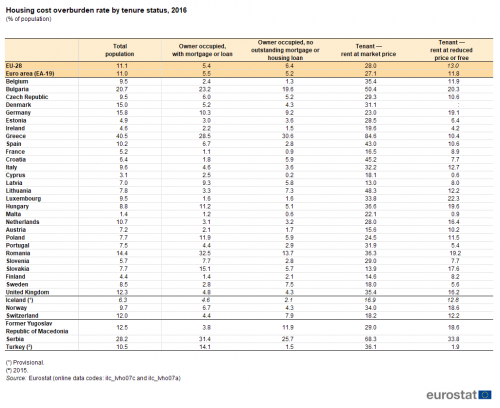
(% of population)
Source: Eurostat (ilc_lvho07c) and (ilc_lvho07a)
The EU-28 average masks significant differences between the EU Member States: at one extreme there were a number of countries where a relatively small proportion of the population lived in households where housing costs exceeded 40 % of their disposable income, notably Malta (1.4 %) and Cyprus (3.1 %). At the other extreme, just over two out of every five people (40.5 %) in Greece and just over one in five (20.7 %) of the population in Bulgaria spent more than 40 % of their equivalised disposable income on housing, as did around one in six people in Germany (15.8 %) and Denmark (15.0 %).
Looking at the tenure status with the highest proportion of the population where housing costs exceeded 40 % of their disposable income, namely tenants with market price rents, there were also large differences between the EU Member States, with some reporting very high proportions in 2016. In 10 Member States, more than one third of the population living as tenants with market price rents spent more than 40 % of their equivalised disposable income on housing, with this proportion of the population exceeding two fifths in Spain (43.0 %), Croatia (45.2 %) and Lithuania (48.3 %), just passing a half (50.4 %) in Bulgaria, and reaching 84.6 % in Greece.
Source data for tables and graphs
Data sources
The data used in this article are primarily derived from microdata from EU statistics on income and living conditions (EU-SILC). The reference population is all private households and their current members residing in the territory of an EU Member State at the time of data collection; persons living in collective households and in institutions are generally excluded from the target population. The data for the EU-28 and the euro area are population-weighted averages of data for the Member States.
Context
Homes impact on the quality of life of households in many ways: providing shelter, security, privacy and a space in which to relax, learn and live. Homes can also be seen in the context of their local environment, in terms of their ease of access to childcare, educational establishments, employment, recreational opportunities, shops, public services and so on. Financing housing, whether purchased or rented, is a major issue for many households, often linked to housing quality.
The EU does not have any specific responsibilities with respect to housing; rather, national governments develop their own housing policies. Nevertheless, many of the EU Member States face similar challenges: for example, how to renew housing stocks, how to plan and combat urban sprawl, how to promote sustainable development, how to help young and disadvantage groups to get into the housing market, or how to promote energy efficiency among homeowners.
Questions of social housing, homelessness or integration play an important role within the EU’s social policy agenda. The charter of fundamental rights stipulates in Article IV-34 that ‘in order to combat social exclusion and poverty, the Union recognises and respects the right to social and housing assistance so as to ensure a decent existence for all those who lack sufficient resources, in accordance with Community law and national laws and practices’. Within this context, a European Council meeting in Nice in 2000, reached an agreement on a set of common objectives for the EU’s strategy against poverty and social exclusion, including two objectives related to housing, namely ‘to implement policies which aim to provide access for all to decent and sanitary housing, as well as basic services necessary to live normally having regard to local circumstances (electricity, water, heating, etc.)’ and ‘to put in place policies which seek to prevent life crises, which can lead to situations of social exclusion, such as indebtedness, exclusion from school and becoming homeless’. This remit was extended in 2010 when the European platform against poverty and social exclusion (COM(2010) 758 final) set out a series of actions to help reduce the number of people at risk of poverty or social exclusion by at least 20 million persons by 2020 (compared with 2008) — see also the article on people at risk of poverty or social exclusion.
Direct access to
- European social statistics — 2013 edition — Statistical books
- Housing conditions in Europe — Statistics in focus 4/2011
- Living conditions in Europe — 2014 edition — Statistical books
- Quality of life - Facts and views — Statistical books
- Income and living conditions (t_ilc), see
- Living conditions (t_ilc_lv)
- Housing conditions (t_ilc_lvho)
- Overcrowding rate (t_ilc_lvho_or)
- Housing cost burden (t_ilc_lvho_hc)
- Housing conditions (t_ilc_lvho)
- Material deprivation (t_ilc_md)
- Housing deprivation (t_ilc_mdho)
- Living conditions (t_ilc_lv)
- Income and living conditions (ilc), see
- Living conditions (ilc_lv)
- Housing conditions (ilc_lvho)
- Overcrowding rate (ilc_lvho_or)
- Under-occupied dwellings (ilc_lvho_uo)
- Housing cost burden (ilc_lvho_hc)
- Housing conditions (ilc_lvho)
- Material deprivation (ilc_md)
- Housing deprivation (ilc_mdho)
- Living conditions (ilc_lv)
- Income and living conditions (ESMS metadata file — ilc_esms)
- The production of data on homelessness and housing deprivation in the European Union: survey and proposals — 2005
- Regulation (EC) No 1177/2003 of 16 June 2003 concerning Community statistics on income and living conditions (EU-SILC)
- Regulation (EC) No 1553/2005 of 7 September 2005 amending Regulation 1177/2003 concerning Community statistics on income and living conditions (EU-SILC)
- Regulation (EU) No 1157/2010 of 9 December 2010 implementing Regulation 1177/2003 concerning Community statistics on income and living conditions (EU-SILC), as regards the 2012 list of target secondary variables on housing conditions
- European Commission — Directorate-General for Employment, Social Affairs & Inclusion — Employment and Social Development in Europe (2017)
- European Commission — Directorate-General for Employment, Social Affairs & Inclusion — Employment and Social Development in Europe — Quarterly Review — Winter 2017
- European Commission — Directorate-General for Employment, Social Affairs & Inclusion — Homelessness
- European Commission — Directorate-General for Employment, Social Affairs & Inclusion — Synthesis report: peer review on sustainable ways of preventing homelessness (2014)
- OECD — Housing
- United Nations — Housing
- WHO — Housing and health
